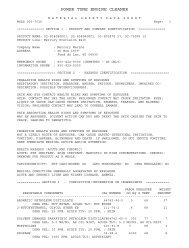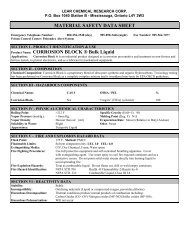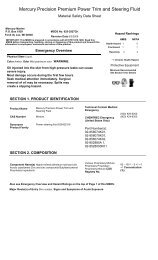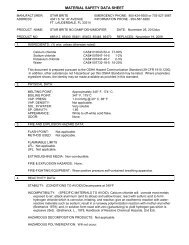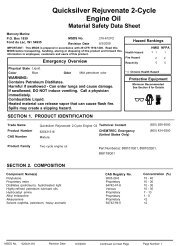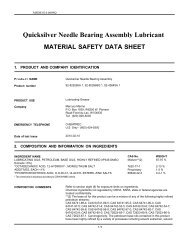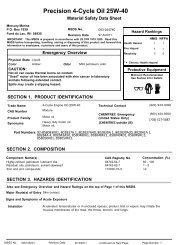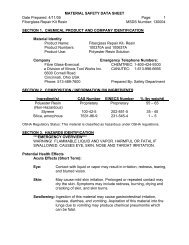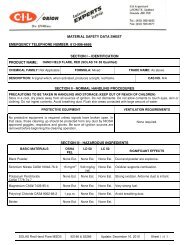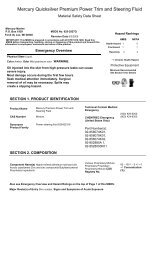Power Steering Fluid SAE 0W30 - Mercury Marine
Power Steering Fluid SAE 0W30 - Mercury Marine
Power Steering Fluid SAE 0W30 - Mercury Marine
Create successful ePaper yourself
Turn your PDF publications into a flip-book with our unique Google optimized e-Paper software.
<strong>Mercury</strong> <strong>Marine</strong> Synthetic Motor Oil, <strong>SAE</strong> 0W-30<br />
SECTION 3. HAZARDS IDENTIFICATION<br />
Also see Emergency Overview and Hazard Ratings on the top of Page 1 of this MSDS.<br />
Major Route(s) of Entry Skin contact.<br />
Signs and Symptoms of Acute Exposure<br />
Inhalation<br />
Eye Contact<br />
Skin Contact<br />
Ingestion<br />
Chronic Health Effects<br />
Summary<br />
Conditions Aggravated<br />
by Exposure<br />
Target Organs<br />
Carcinogenic Potential<br />
At elevated temperatures or in enclosed spaces, product mist or vapors may irritate the<br />
mucous membranes of the nose, the throat, bronchi, and lungs.<br />
This product can cause transient mild eye irritation with short-term contact with liquid sprays<br />
or mists. Symptoms include stinging, watering, redness, and swelling.<br />
This product can cause mild, transient skin irritation. Skin contact with hot material may<br />
result in severe burns.<br />
If swallowed, this material can cause a laxative effect.<br />
This product contains a petroleum-based mineral oil. Prolonged or repeated skin contact<br />
can cause mild irritation and inflammation characterized by drying, cracking, (dermatitis) or<br />
oil acne. Repeated or prolonged inhalation of petroleum-based mineral oil mists at<br />
concentrations above applicable workplace exposure levels can cause respiratory irritation or<br />
other pulmonary effects.<br />
Disorders of the following organs or organ systems that may be aggravated by significant<br />
exposure to this material or its components include: Skin<br />
May cause damage to the following organs: skin.<br />
This product is not known to contain any components at concentrations above 0.1% which<br />
are considered carcinogenic by OSHA, IARC or NTP.<br />
OSHA Hazard Classification is indicated by an "X" in the box adjacent to the hazard title. If no "X" is present,<br />
the product does not exhibit the hazard as defined in the OSHA Hazard Communication Standard (29 CFR<br />
1910.1200).<br />
OSHA Health Hazard Classification<br />
OSHA Physical Hazard Classification<br />
Irritant<br />
Toxic<br />
Corrosive<br />
Sensitizer<br />
Highly Toxic<br />
Carcinogenic<br />
Combustible Explosive Pyrophoric<br />
Flammable Oxidizer Water-reactive<br />
Compressed Gas Organic Peroxide Unstable<br />
SECTION 4. FIRST AID MEASURES<br />
Take proper precautions to ensure your own health and safety before attempting rescue or providing first aid.<br />
For more specific information, refer to Exposure Controls and Personal Protection in Section 8 of this MSDS.<br />
Inhalation<br />
Eye Contact<br />
Vaporization is not expected at ambient temperatures. This material is not expected to cause<br />
inhalation-related disorders under anticipated conditions of use. In case of overexposure,<br />
move the person to fresh air.<br />
Check for and remove contact lenses. Flush eyes with cool, clean, low-pressure water while<br />
occasionally lifting and lowering eyelids. Seek medical attention if excessive tearing, redness,<br />
or pain persists.<br />
MSDS No. 167-6077K Revision Date 3/10/2008 Continued on Next Page Page Number: 2



